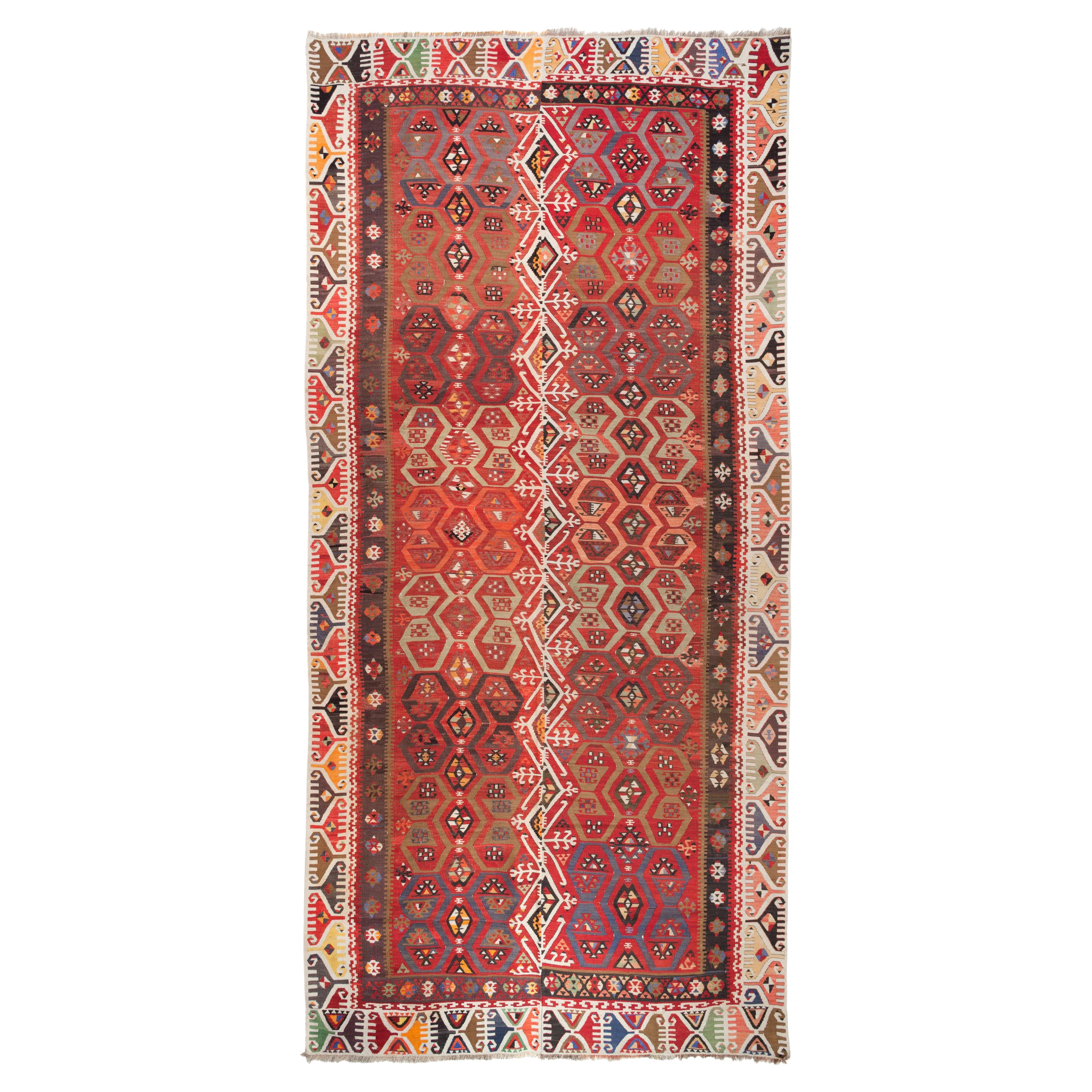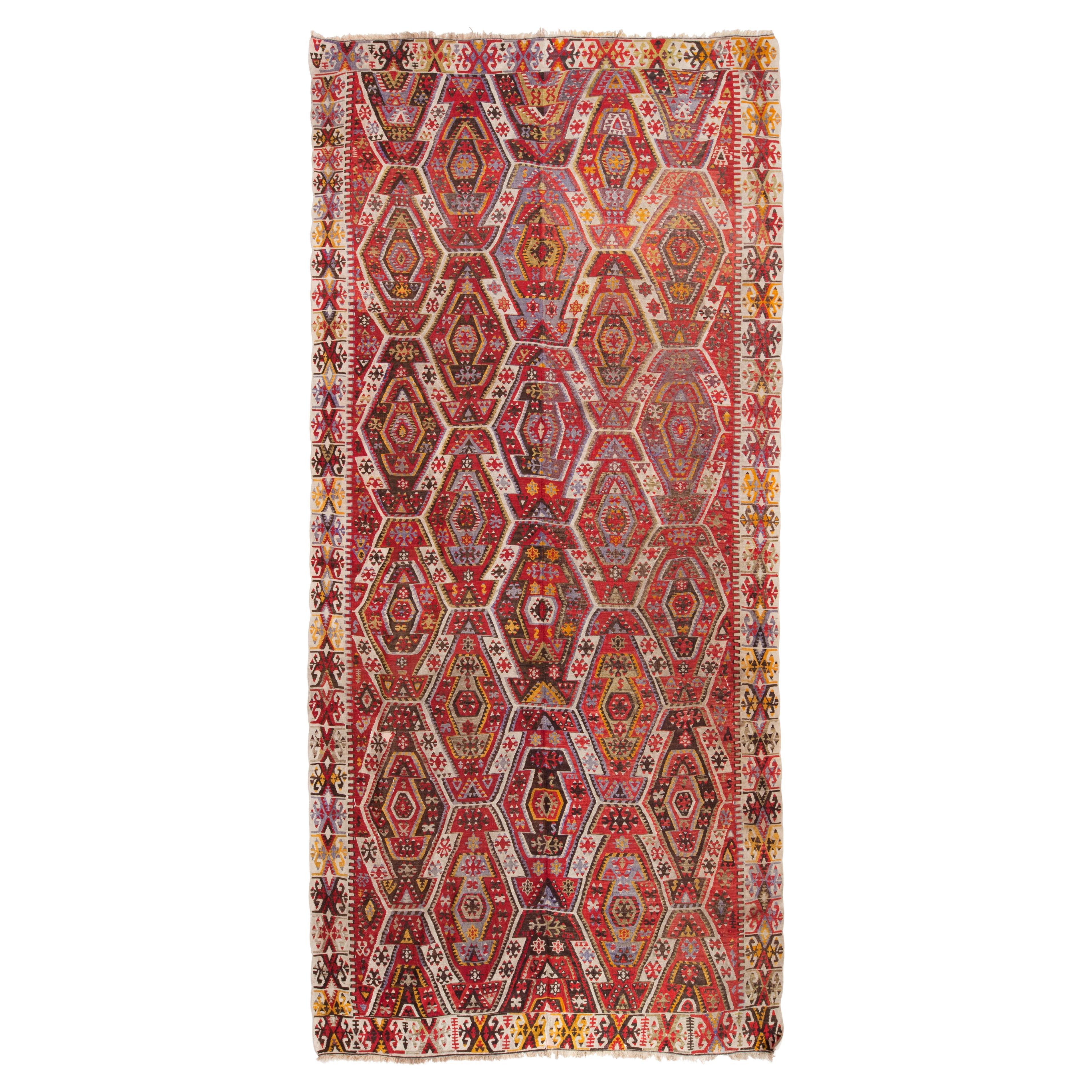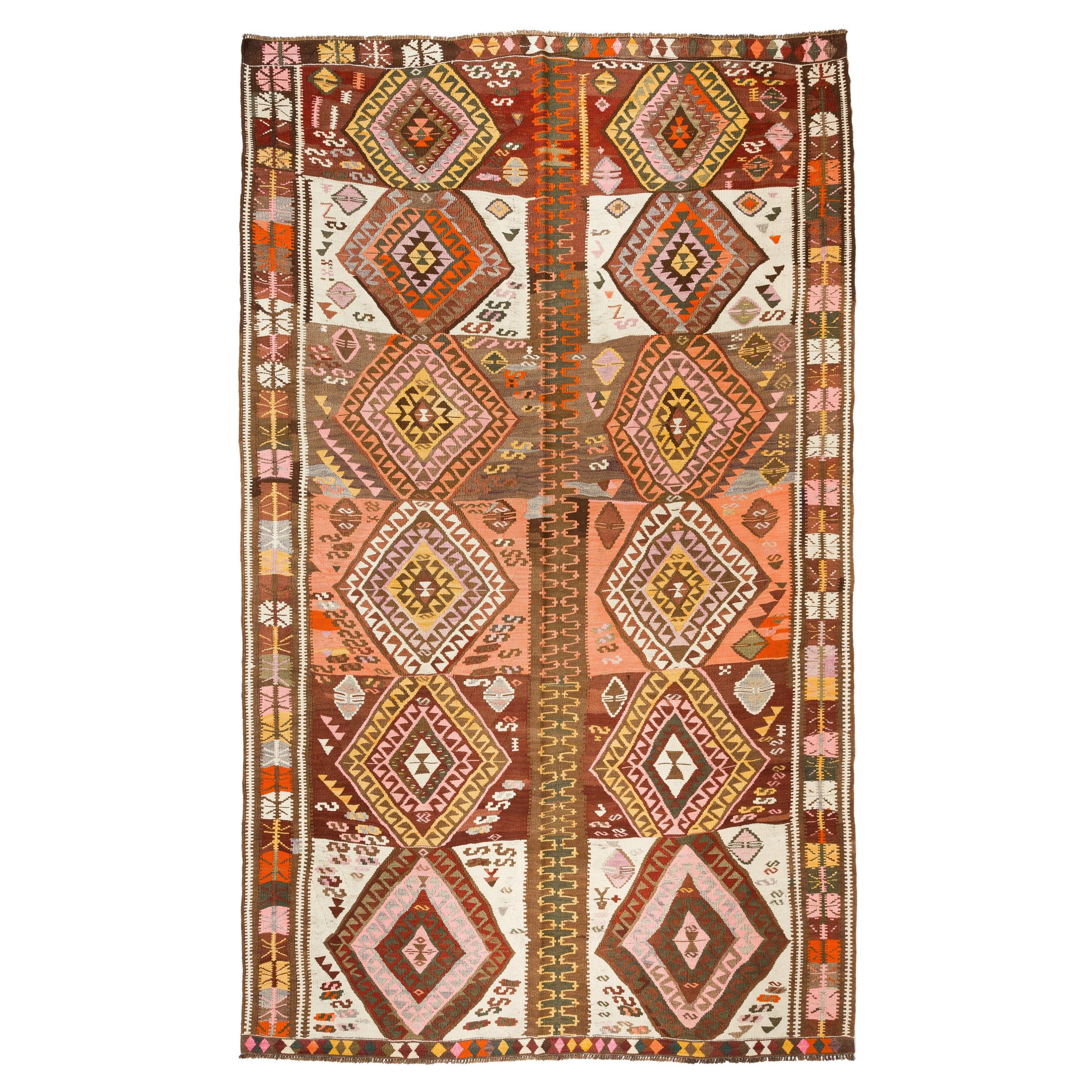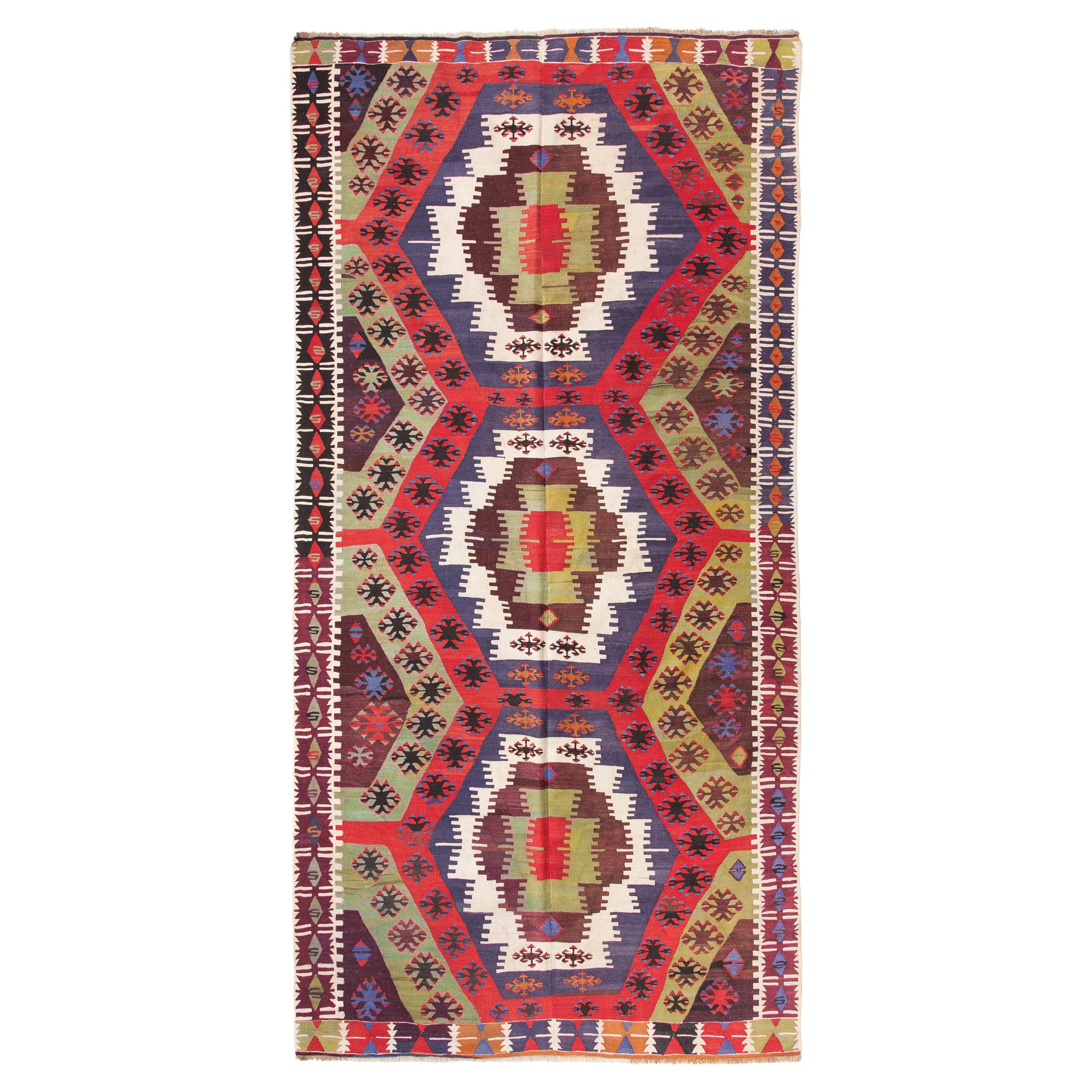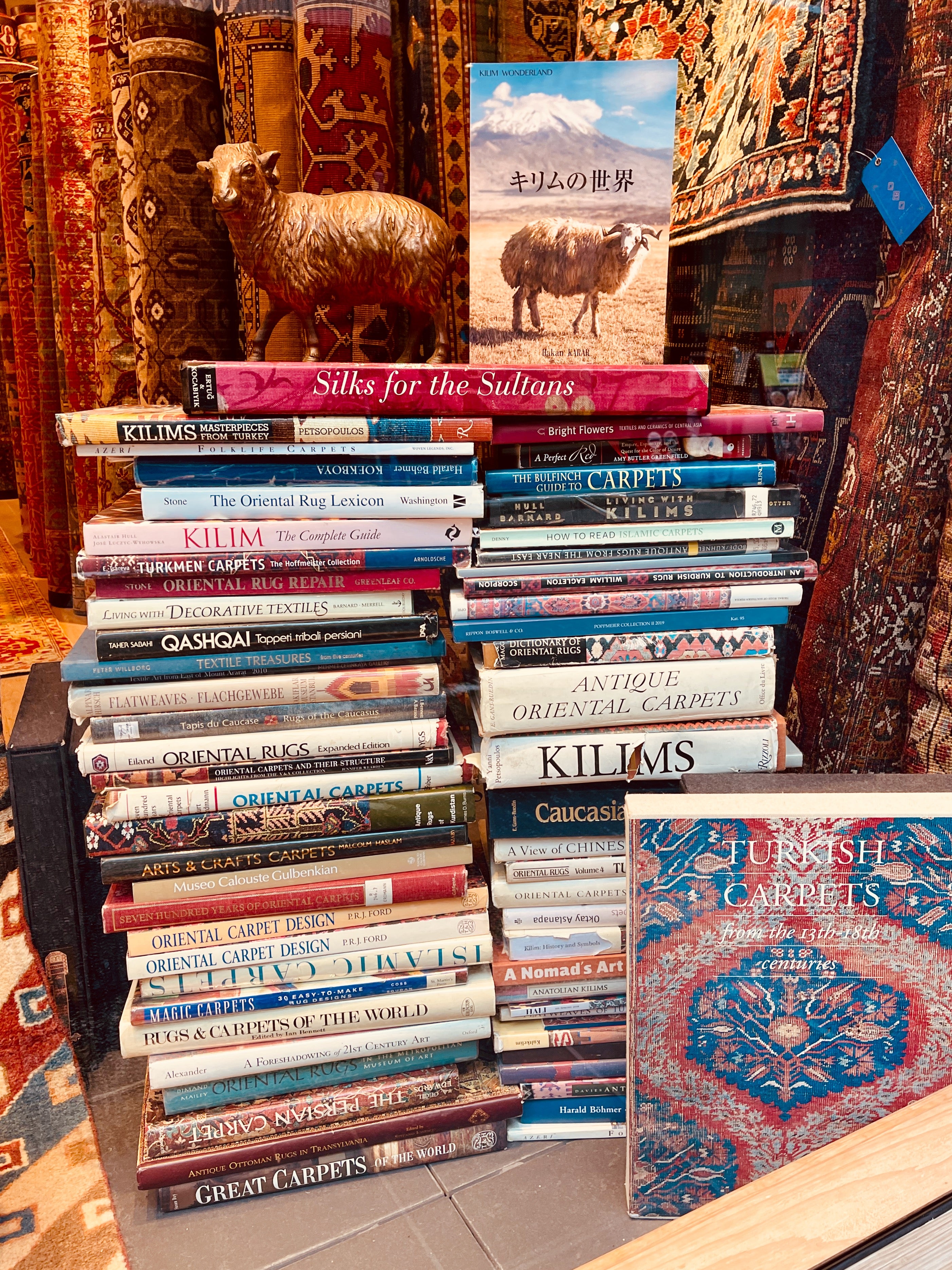Items Similar to Old Adana Kilim Southern Anatolian Carpet Turkish Rug
Want more images or videos?
Request additional images or videos from the seller
1 of 6
Old Adana Kilim Southern Anatolian Carpet Turkish Rug
About the Item
This is a Southern Anatolian made in two halves of old Kilim from the Adana region with a rare and beautiful color composition.
Adana Situated in the fertile Çukurova plain (previously known as the Cilician plain, through which the Seyhan and Ceyhan rivers run), Adana is a busy industrial and agricultural center. The region has always benefited from its location on the Arab and Anatolian trade routes by controlling the passes through the Taurus Mountains to Syria. A Hittite settlement existed there from 1400 BC and the land was conquered by Alexander the Great in the fourth century BC. From the late thirteenth century to the eighteenth century Adana was ruled by the Turkoman Ramazan dynasty, succeeded in turn by Ottoman rule. Large kilims made in two halves often have medallions of various shapes hexagonal diamonds, for example - as a main feature, whereas others have small and repetitive motifs, such as a hooked diamond shape enclosed within a hexagon, filling the main field. Single borders are usually found on both large and small kilims. The small kilims differ widely in design; amongst others, some prayer-arch kilims and some with hexagonal hooked motifs can be seen. Kilims continue to be woven in the villages of the Adana region that are made according to the weavers' taste, and as with other modern village kilims, the colors need the benefit of two months' sun-fading to become saleable. The Adana region produces much cotton, and its kilims often have cotton warps. Cotton is also used for color contrast in both border and field, where reds, pink, orange, green, purple, and blue fading to grey are also common. The older kilims are of medium- and fine-spun wool whereas the modern kilims are becoming very coarse and loosely woven. Slitweave is the prevalent weaving technique in the area.
On the far west tip of the Cilician plain, south-west of Adana and close to the Mediterranean Sea, the town of Silifke was founded in the third century BC by the Alexandran general Seleucus Nicator, who established the Seleucid dynasty that ruled Syria. Silifke is also known as the place where Emperor Frederick Barbarossa met his demise during the Third Crusade, by falling off his horse into the river! Kilims made in this region are normally small or medium in size. Yastiks and çuval are also woven in çiçim, zili, and weft-wrapping techniques. The design often consists of a thin elibelinde mother-goddess motif repeated in different colors in vertical lines - this creates an interesting three-dimensional effect. Colors used include red, brown, orange, pink, some blue and green, and white cotton.
- Dimensions:Width: 66.93 in (170 cm)Length: 141.74 in (360 cm)
- Style:Kilim (In the Style Of)
- Materials and Techniques:
- Place of Origin:
- Period:
- Date of Manufacture:circa 1950
- Condition:Wear consistent with age and use. Minor fading.
- Seller Location:Tokyo, JP
- Reference Number:1stDibs: LU8206233322422
ARARAT RUGS
We know and believe that the geography we come from, our past, and our lifestyle are the most important bond between us to carry the oriental carpet art and culture to the next generations along with our core values in our ongoing growth journey.
We are aware that the way to achieve this goal and carry this priceless art and culture to the future depends on a lot of work with all our people every day while adhering to our core values.
For us, art is meaningful in the sense that it brings together various cultures around the world. It is an honor for us that oriental carpet art and culture have been instrumental in this for centuries and that we are a part of this business.
We are tirelessly keeping an eye on auction house information around the world about carpets. New York's Metropolitan, London's Victoria & Albert Museums, and other famous art museums, as well as small specialized museums that house private collections, and books about oriental carpets to collect information on outstanding carpet designs and patterns from around the world. It's our Self-improving and Self-developing culture.
As Turkish Culture of Hospitality, the Kurdish Culture of Generosity, and as Japanese Culture of Business Punctuality; are the most important values that this multicultural background has taught and bequeathed to us. It is essential and valuable for us that you feel this feeling not only by looking at our oriental carpets but from the moment you contact us.
About the Seller
5.0
Vetted Seller
These experienced sellers undergo a comprehensive evaluation by our team of in-house experts.
Established in 1970
1stDibs seller since 2023
13 sales on 1stDibs
Typical response time: 1 hour
- ShippingRetrieving quote...Ships From: Tokyo, Japan
- Return PolicyA return for this item may be initiated within 7 days of delivery.
More From This SellerView All
- Old Adana Kilim Southern Anatolian Carpet Turkish RugLocated in Tokyo, JPThis is a Southern Anatolian made in two halves of old Kilim from the Adana region with a rare and beautiful color composition. Adana Situated in the fertile Çukurova plain (previ...Category
Mid-20th Century Turkish Kilim Turkish Rugs
MaterialsWool, Natural Fiber
- Antique Adana Kilim Rug Wool Old Eastern Anatolian Turkish CarpetLocated in Tokyo, JPThis is Eastern Anatolian Antique Kilim from the Adana region with a rare and beautiful color composition. This highly collectible antique kilim has wonderful special colors and tex...Category
Early 20th Century Turkish Kilim Turkish Rugs
MaterialsWool, Natural Fiber
- Vintage Malatya Kilim Rug Old Anatolian Turkish CarpetLocated in Tokyo, JPThis is a South Eastern Anatolian old vintage Kilim from the Malatya region with a rare and beautiful color composition. Malatya is Turkey's main kilim production area, and there are many variations. This is one of them, a runner-type kilim. The thread is thin and the weave is very fine and dense. Some metallic threads are used in this antique kilim, which is rarely seen in Anatolian kilims. Red, navy blue, and gray are the colors that determine the impression of this kilim. Other colors such as brown, yellow, and light blue are also used in the patterns. The wavy horizontal striped pattern, plain pattern, and lined motif pattern are woven together to create a kilim that looks like an obi. The pattern of the motif and the pattern of the wave are about the same amounts, giving a lively impression without getting busy. The deep shades of colors and patterns that are familiar to each other are unique to antiques. However, it still retains good coloring which makes it hard to believe that it is antique. The runner type is a good type to make this kilim unique. Also, for those who want to create a different kind of home, the use of runners is very effective. Malatya is a town built on one main street that continues for several miles. It is situated in the Tohmasuyu River basin which is encircled by the high peaks of the eastern Taurus Mountains. This is a fertile agricultural region, particularly for apricots, and has been a prolific weaving area for many years. The modern town was established in 1838; old Malatya, which is close by, was once an important city in Armenia Minor. In Roman times it was important as a garrison town on the eastern frontier, and the settlement came under Ottoman rule in the early fifteenth century. Considering the number of kilims woven in this region there is a surprising lack of diversity in design, especially in the larger kilims; this is possibly a direct result of the Kurdish tribal tradition of weaving only one type of design. Small prayer rugs...Category
Mid-20th Century Turkish Kilim Turkish Rugs
MaterialsWool, Natural Fiber
- Vintage Kars Kilim Rug Old Anatolian Turkish CarpetLocated in Tokyo, JPThis is an Eastern Anatolian Vintage Kilim from the Kars region with a rare and beautiful color composition. The old sector and newer southern districts of Kars are joined by a br...Category
Mid-20th Century Turkish Kilim Turkish Rugs
MaterialsWool, Organic Material, Natural Fiber
- Old Kayseri Kilim Central Anatolian Rug Turkish CarpetLocated in Tokyo, JPThis is a Central Anatolian Old Kilim from the Kayseri region with a rare and beautiful color composition. The earliest recorded occupation of Kayseri dates back to Hellenistic ti...Category
Mid-20th Century Turkish Kilim Turkish Rugs
MaterialsWool, Natural Fiber
- Vintage Malatya Kilim Rug Old Anatolian Turkish CarpetLocated in Tokyo, JPThis is a South Eastern Anatolian old vintage Kilim from the Malatya region with a rare and beautiful color composition. Malatya is a town built on one main street that continues for several miles. It is situated in the Tohmasuyu River basin which is encircled by the high peaks of the eastern Taurus Mountains. This is a fertile agricultural region, particularly for apricots, and has been a prolific weaving area for many years. The modern town was established in 1838; old Malatya, which is close by, was once an important city in Armenia Minor. In Roman times it was important as a garrison town on the eastern frontier, and the settlement came under Ottoman rule in the early fifteenth century. Considering the number of kilims woven in this region there is a surprising lack of diversity in design, especially in the larger kilims; this is possibly a direct result of the Kurdish tribal tradition of weaving only one type of design. Small prayer rugs...Category
Mid-20th Century Turkish Kilim Turkish Rugs
MaterialsWool, Natural Fiber, Organic Material
You May Also Like
- Vintage Turkish Anatolian CarpetLocated in New York, NYA vintage Turkish Anatolian carpet from the mid-20th century with cotton highlights.Category
Mid-20th Century Turkish Oushak Turkish Rugs
MaterialsWool, Cotton
- Vintage Turkish Anatolian CarpetLocated in New York, NYA vintage Turkish Anatolian carpet from the mid-20th century.Category
Mid-20th Century Turkish Tribal Turkish Rugs
MaterialsWool
- Vintage Turkish Anatolian CarpetLocated in New York, NYA vintage Turkish Anatolian carpet from the mid-20th century.Category
Mid-20th Century Turkish Tribal Turkish Rugs
MaterialsWool
- Antique Central Anatolian Kilim RugLocated in New York, NYAntique Central Anatolian Kilim rug. A great example of Anatolian Kilim rug weaving from the 19th century when tribal women wove such pieces as...Category
Antique Late 19th Century Turkish Kilim Turkish Rugs
MaterialsWool
- Vintage Turkish Anatolian RugLocated in New York, NYA vintage Turkish Anatolian rug from the mid-20th century. Measures: 7' 3" x 9' 2".Category
Mid-20th Century Turkish Tribal Turkish Rugs
MaterialsWool
- Vintage Turkish Sharkoy Kilim RugLocated in Torquay, GBVintage Turkish Sharkoy Kilim rug. Large sized 325cm x 225cm Monumental large area rug measuring over 3metres wide. Beautiful Ikat pattern with vibrant colours. Tightly woven cott...Category
Mid-20th Century Turkish Kilim Turkish Rugs
MaterialsCotton
